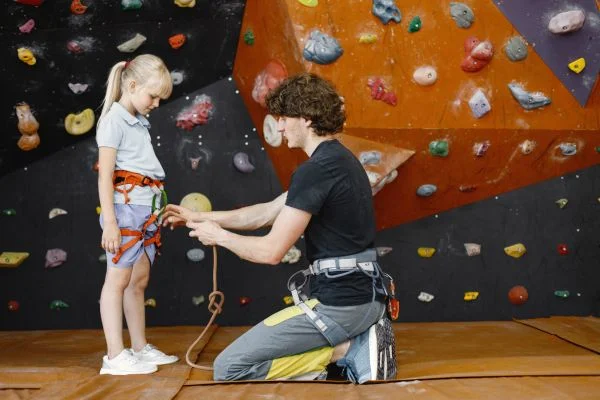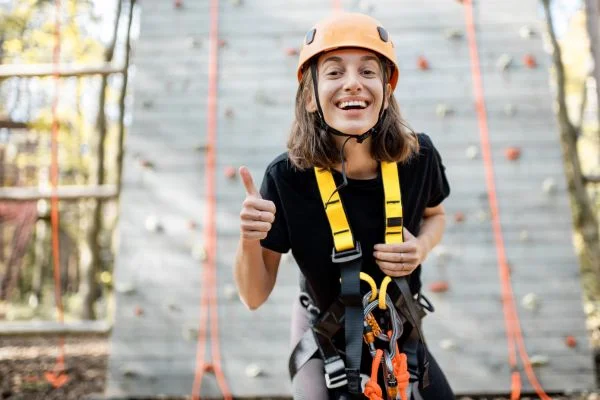Climbing harnesses are one of the essential pieces of equipment for any climber. As such, ensuring that your climbing harness fits correctly is vital. There are a few key things to look out for when it comes to getting the correct fit. Read on to find out what they are and how should a climbing harness fit properly.
A climbing harness should fit snugly but not overly tight, allowing freedom of movement. It should sit comfortably above the hips, with leg loops snug but not constricting, and all buckles properly secured for safety.
How Should a Climbing Harness Fit | Pro Tips

Getting the Right Size
The first step in finding the right size rock climbing harness is determining your waist size. To do this, you will need a measuring tape and someone else to help you.
First, measure around your waist at its widest point (usually just above your hipbones) and make sure that the tape is snug but not too tight. This measurement should be used as a reference when sizing up or choosing your climbing harness.
Checking Comfortability & Mobility
Once you have determined what size you need, it’s time to try on different sizes of harnesses until you find one that fits comfortably and allows for a full range of motion without being too loose or too tight.
Next, check how tightly the leg loops fit and if they are adjustable; adjust them accordingly until they feel comfortable but not too tight or loose. You should also ensure that everything feels secure when tightening your buckles; if it doesn’t feel secure, it probably isn’t!
Finally, test any gear loops or other accessories before taking it out with you on a climb – if anything seems off, don’t take it out with you!
Testing It Out
Once you have found a climbing harness that fits well and feels comfortable, now is the time to test it out! Take some time to practice belaying and rappelling to understand better how comfortable and secure the harness feels while wearing it.
Also, try doing dynamic movements like traversing across a wall or boulder – this will give you an idea of how well-balanced the weight distribution is throughout the entire body while using the climbing harness.
Once everything feels proper and secure, it’s time to hit those rocks!
Also Read: How Long Do Climbing Harnesses Last?
The Other Things Your Need To Consider
The most important thing to consider when choosing a climbing harness is how it fits your body. To ensure a good fit, pay attention to the waistbelt, leg loops, and gear loops. Let’s take a closer look at each one.
Waistbelt: The waistbelt should fit snugly around your hips so that it doesn’t move or slip while climbing. It should also provide enough support so that it doesn’t dig into your skin while in use. To ensure the waistbelt isn’t too tight or loose, try adjusting the straps until they are comfortable but still secure.
Leg Loops: The next area to consider is the leg loops. These should be adjustable enough so that they don’t dig into your thighs or restrict movement while you climb. Also, ensure enough space between them for easy mobility when reaching for holds or maneuvering through tricky terrain.
Gear Loops: Finally, check out the gear loops on your harness—these are designed to hold additional items like carabiners and quickdraws during long climbs so that everything stays within reach as needed. Make sure these are also adjustable—you don’t want them too tight against your body, as this could interfere with breathing and movement while in use.
Also Read: How To Climb a Tree With a Harness?
How Tight Should Legs Be On a Climbing Harness?
When it comes to getting ready for a day of climbing, a few pieces of equipment are as important as your harness. A harness should be snug enough to ensure your safety while climbing but loose enough that you don’t feel uncomfortable or restricted.
You should ensure the leg loops fit snugly on the highest points of your thighs and that the waist belt sits at about hipbone level. The waist belt doesn’t need to be so tight that you can’t take deep breaths, but it should be tightened until you can fit two fingers between your body and the waist belt.
That way, it will keep you secure without digging into your skin. Lastly, when you’re all suited up (and before you start climbing!), double-check everything so you can be assured that you are well-prepared to tackle your next adventure.
Also Read: How Much Weight Can a Climbing Harness Hold?
Conclusion:
So now you know how should a climbing harness fit. Finding the correct fitting climbing harness can be tricky, but some guidelines can help ensure your next purchase fits perfectly!
Make sure to measure yourself accurately before choosing a size; check its comfortability and mobility by adjusting straps where necessary, and finally, test it out before hitting those rocks! With these tips in mind, finding a well-fitting climbing harness should be more accessible than ever!



